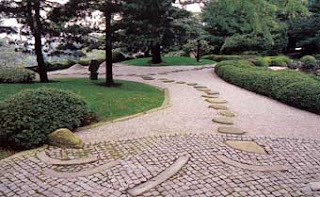Design with Sound in a Garden
close up of glass wind chimes
Sound is an overlooked element in landscape design.
When you think of sounds in a garden you most likely conjure up images of birds singing, leaves rustling or bees buzzing but there are many more subtle auditory effects you can use - and I am not just talking about wind chimes.
For some ideas we can look to ancient Japanese gardens where sound was a key consideration in the overall plan.
When you think of sounds in a garden you most likely conjure up images of birds singing, leaves rustling or bees buzzing but there are many more subtle auditory effects you can use - and I am not just talking about wind chimes.
For some ideas we can look to ancient Japanese gardens where sound was a key consideration in the overall plan.
Stone Path - Japanese Garden at Kykuit
This is described beautifully in a text on the Japanese Garden at Rockefeller's Kykuit garden in Pocantico, NY written by Cynthia Bronson Altman:
"... The hollow tones of the shishi-odoshi (lit. 'deer-scare') – a rhythmic knock of bamboo on rock – the splash of the waterfall into a deep pool, the rustle of breezes through the bamboo, mute the rush of the world today, creating a space for contemplation and meditation, for a mindful walk..., transporting one to another world, another reality."
Wow. I couldn't have said it better.
The Japanese gardeners used sound to heighten the sense of 'near' and 'far' in a garden.
They would make a cascade seem far away by muffling its sound with strategically placed plants or rocks. The obstacles bounced the sound back and created the impression that the waterfall was in the distance when it was really around the corner along the garden path!
They would make a cascade seem far away by muffling its sound with strategically placed plants or rocks. The obstacles bounced the sound back and created the impression that the waterfall was in the distance when it was really around the corner along the garden path!
in Hyartt Hotel in Kauai
This is why I always plant around a waterfall with great care, placing the plants where they might muffle the sound...
I normally locate evergreens on one side of a waterfall to act as a visual backdrop and as a sound buffer. These plants may include hemlock, rhododendron, Manhattan euonymus, Dwarf threadleaf cypress (Chamaecyparis pisifera filifera), weeping norway spruce, boxwood and leatherleaf Viburnum.
I also use smaller plants in the front or front side of a cascade such as Persicaria affinis 'Donald Lowndes' (Knotweed or Fleeceflower), dwarf Chinese Astilbe (Astilbe chinensis pumila), Japanese Painted Fern (Athyrium niponicum ‘Pictum’), Maidenhair fern, Iris, sedum and various varieties of cotoneaster.
ascade by Jan Johnsen
I also use smaller plants in the front or front side of a cascade such as Persicaria affinis 'Donald Lowndes' (Knotweed or Fleeceflower), dwarf Chinese Astilbe (Astilbe chinensis pumila), Japanese Painted Fern (Athyrium niponicum ‘Pictum’), Maidenhair fern, Iris, sedum and various varieties of cotoneaster.
Similarly, Japanese garden designers would play with the sound of footsteps. In old Japan
Thus, garden paths paved with stone intensified the sound of footfalls while paths of tamped earth dampened the sound considerably. And, of course, gravel paths provided a crunching sound. Alas, our soft-soled shoes of today do not make the sound of a path as obvious but it is still audible.
There are a lot more sound ideas that I will share in another blog post....but I hope the sounds of the season will now grab your attention!
Thus, garden paths paved with stone intensified the sound of footfalls while paths of tamped earth dampened the sound considerably. And, of course, gravel paths provided a crunching sound. Alas, our soft-soled shoes of today do not make the sound of a path as obvious but it is still audible.
Crunchy Gravel Walk with Step Stones - a Collaborative Design between Jan and Marc
There are a lot more sound ideas that I will share in another blog post....but I hope the sounds of the season will now grab your attention!
Look here for some fun step stones....Nichols Bros. Stepstones














Such good points - a garden should appeal to all the senses.
ReplyDeletethis is a fantastic blog post! i am designing a japanese style garden on the western coast of norway and this blog has inspired me greatly. thank you :)
ReplyDeleteYou are welcome! My family is from Norway..kindred spirits.
ReplyDeleteyou are very welcome!more to come....
ReplyDelete